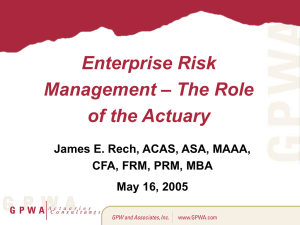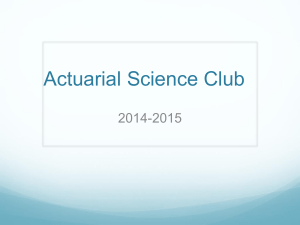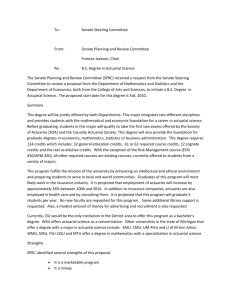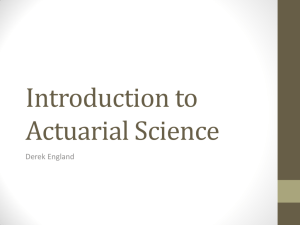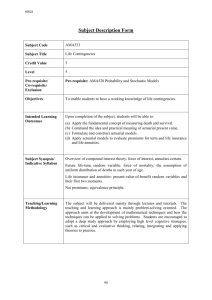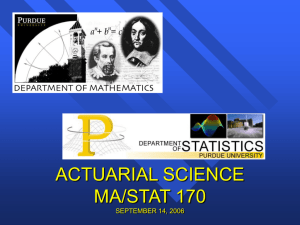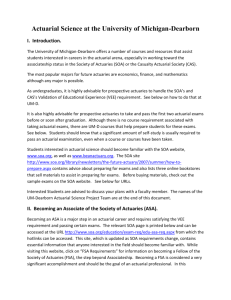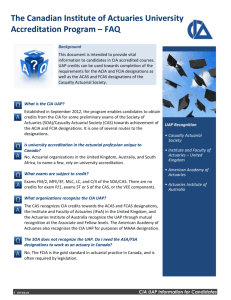ACT240 Sum 12 Outline vog
advertisement
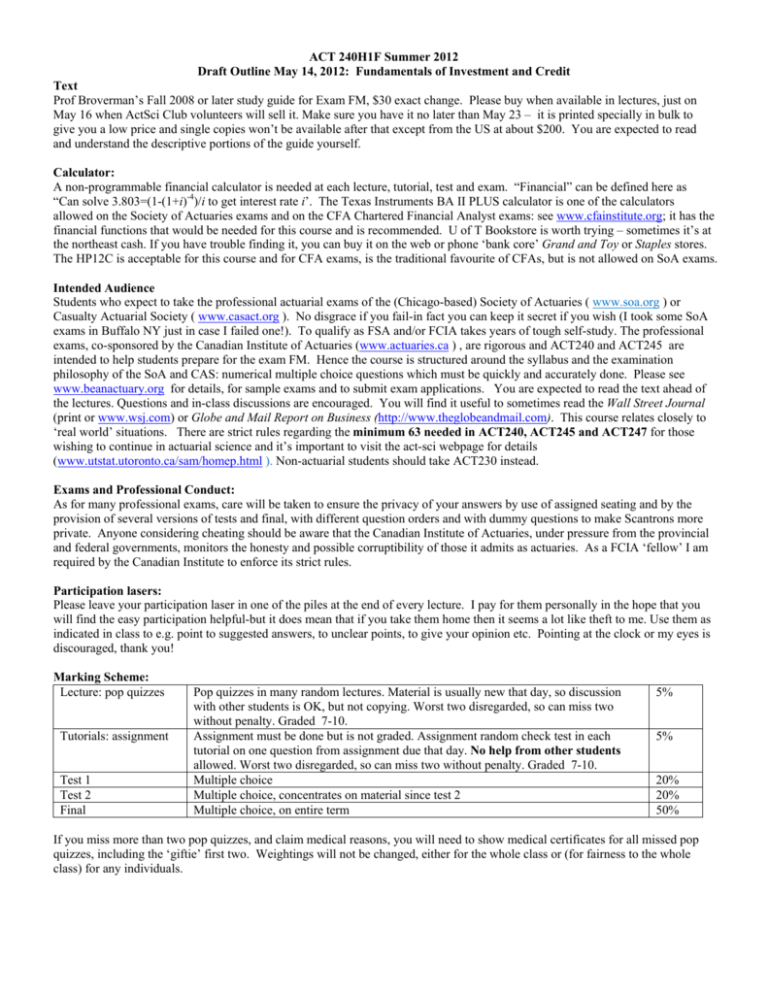
ACT 240H1F Summer 2012 Draft Outline May 14, 2012: Fundamentals of Investment and Credit Text Prof Broverman’s Fall 2008 or later study guide for Exam FM, $30 exact change. Please buy when available in lectures, just on May 16 when ActSci Club volunteers will sell it. Make sure you have it no later than May 23 – it is printed specially in bulk to give you a low price and single copies won’t be available after that except from the US at about $200. You are expected to read and understand the descriptive portions of the guide yourself. Calculator: A non-programmable financial calculator is needed at each lecture, tutorial, test and exam. “Financial” can be defined here as “Can solve 3.803=(1-(1+i)-4)/i to get interest rate i’. The Texas Instruments BA II PLUS calculator is one of the calculators allowed on the Society of Actuaries exams and on the CFA Chartered Financial Analyst exams: see www.cfainstitute.org; it has the financial functions that would be needed for this course and is recommended. U of T Bookstore is worth trying – sometimes it’s at the northeast cash. If you have trouble finding it, you can buy it on the web or phone ‘bank core’ Grand and Toy or Staples stores. The HP12C is acceptable for this course and for CFA exams, is the traditional favourite of CFAs, but is not allowed on SoA exams. Intended Audience Students who expect to take the professional actuarial exams of the (Chicago-based) Society of Actuaries ( www.soa.org ) or Casualty Actuarial Society ( www.casact.org ). No disgrace if you fail-in fact you can keep it secret if you wish (I took some SoA exams in Buffalo NY just in case I failed one!). To qualify as FSA and/or FCIA takes years of tough self-study. The professional exams, co-sponsored by the Canadian Institute of Actuaries (www.actuaries.ca ) , are rigorous and ACT240 and ACT245 are intended to help students prepare for the exam FM. Hence the course is structured around the syllabus and the examination philosophy of the SoA and CAS: numerical multiple choice questions which must be quickly and accurately done. Please see www.beanactuary.org for details, for sample exams and to submit exam applications. You are expected to read the text ahead of the lectures. Questions and in-class discussions are encouraged. You will find it useful to sometimes read the Wall Street Journal (print or www.wsj.com) or Globe and Mail Report on Business (http://www.theglobeandmail.com). This course relates closely to ‘real world’ situations. There are strict rules regarding the minimum 63 needed in ACT240, ACT245 and ACT247 for those wishing to continue in actuarial science and it’s important to visit the act-sci webpage for details (www.utstat.utoronto.ca/sam/homep.html ). Non-actuarial students should take ACT230 instead. Exams and Professional Conduct: As for many professional exams, care will be taken to ensure the privacy of your answers by use of assigned seating and by the provision of several versions of tests and final, with different question orders and with dummy questions to make Scantrons more private. Anyone considering cheating should be aware that the Canadian Institute of Actuaries, under pressure from the provincial and federal governments, monitors the honesty and possible corruptibility of those it admits as actuaries. As a FCIA ‘fellow’ I am required by the Canadian Institute to enforce its strict rules. Participation lasers: Please leave your participation laser in one of the piles at the end of every lecture. I pay for them personally in the hope that you will find the easy participation helpful-but it does mean that if you take them home then it seems a lot like theft to me. Use them as indicated in class to e.g. point to suggested answers, to unclear points, to give your opinion etc. Pointing at the clock or my eyes is discouraged, thank you! Marking Scheme: Lecture: pop quizzes Tutorials: assignment Test 1 Test 2 Final Pop quizzes in many random lectures. Material is usually new that day, so discussion with other students is OK, but not copying. Worst two disregarded, so can miss two without penalty. Graded 7-10. Assignment must be done but is not graded. Assignment random check test in each tutorial on one question from assignment due that day. No help from other students allowed. Worst two disregarded, so can miss two without penalty. Graded 7-10. Multiple choice Multiple choice, concentrates on material since test 2 Multiple choice, on entire term 5% 5% 20% 20% 50% If you miss more than two pop quizzes, and claim medical reasons, you will need to show medical certificates for all missed pop quizzes, including the ‘giftie’ first two. Weightings will not be changed, either for the whole class or (for fairness to the whole class) for any individuals. Medical certificates are carefully and skeptically investigated in accordance with University regulations: A few years ago, 20 out of every 100 students would produce doctors’ certificates. Now University policy is very strictly interpreted and very strictly enforced. Medical certificates must be signed by an Ontario-registered MD, with registration number and phone number, and the date of certificate relative to claimed sickness must be within the limit imposed by University rules. It is essential that the doctor specifically indicates that in his/her opinion there was a disabling health problem on the day of the test. Certificates saying “Needs rest” or “respiratory tract infection” or “injured foot” or similar will be rejected, as will certificates from chiropractors and acupuncturists. The doctor should be contactable by us for verification. It is expected that each student with accepted documentation will be required to take a rigorous make-up test at a chalkboard. If documentation is not provided or is not accepted, your test mark for the missed test will be zero. Note that no excuses, medical or otherwise, are accepted by the Society of Actuaries or CFA Institute if a professional exam is missed. Web Site The timing of lecture coverage will likely deviate from the day-to-day schedule above. This outline and updates are at http://www.utstat.utoronto.ca/sharp. Assignments and other info are posted on the course Blackboard password-accessed portal – you will wish to monitor the portal every few days. Also please ensure that the portal ‘knows’ an email address for you which you monitor frequently, otherwise you’ll miss course-related emails. ‘Only about 40% of students graduated in the U of T actuarial science program eventually get a job in the actuarial field’ (U of T Act Sci Club statement, 2007: formal instructor attempts at data collection are handicapped by university privacy rules). Enrolment in actuarial science programs Canada-wide has multiplied by perhaps five in the last 25 years and entry level actuarial jobs have become much more difficult to find in Canada and most other countries. Graduates with little work experience have often been unable to find an entry level actuarial job. Students enthusiastic about actuarial science and/or CFA are advised to improve their career prospects by developing a broader business background too, to ensure that their Excel skills are competitive, to pass SoA exams and, most of all, to get office work experience. Also enhance your communication skills e.g. by attending a Toastmaster club ( www.toastmasters60.org) and gaining the ‘Competent Toastmaster’ certificate for giving ten 7-minute speeches to about 15 people and using the feedback provided. The Chartered Financial Analyst (CFA) exams are an easier (but not easy) option, make use the material from this course and have a fairly similar examination format: see www.utstat.utoronto.ca/sharp and www.cfainstitute.org . A CFA doesn’t guarantee a job either, but it is widely recognized by many types of employer as distinguishing your resume from a thousand others. ACT240H1F Lecture times, location Course Web Site (please monitor) Instructor L5101 MW4:10-6:00 First lecture is May 14, 2012 at 4:10pm. MW3:10 (t) (First tute is May 16) Blackboard portal. However, the outline will be at http://www.fisher.utstat.toronto.edu/sharp Dr Keith Sharp FCIA FSA CFA sharp@utstat.utoronto.ca Instructor office hours MW 1:30-2:30 TAs: Panpan Wu panpan@utstat.utoronto.ca Lecture May 14 (No tutorial, lecture starts at 4:10pm) May 16 (Tutorial at 3:10pm, lecture 4:10 pm-6:00pm) May 23 May 28, 3:10 pm – 4:00 pm (SS1085 is one location) May 28, 4:10 pm - 6:00 pm May 30 June 4 June 6 Jun 11 3:10 pm – 4:00 pm (SS1085 is one location) Approximate Coverage Effective rates, PV and equation of value Nominal rates, discount, Force interest, Real rates Level payment annuities TERM TEST 1 (NOTE TIME) Generalizations Non-constant payments, Loan Amortization Level payments, mortgages Mortgages, Sinking funds TERM TEST 2 (NOTE TIME) Bond prices & amortization Callable bonds, Internal rate of return Dollar & time-wtd yields, Portfolio & investmentyear June 11 4:10 pm – 6:00 pm June 13 June 18 June 20 FINAL EXAM GOOD LUCK In Jun 25-29 exam week; date to be set by Registrar SS1085 SS6007 FM Study Guide 1, 2 3 4, 5 6, 7 8 9 9, 10 11, 12 12 13 13
